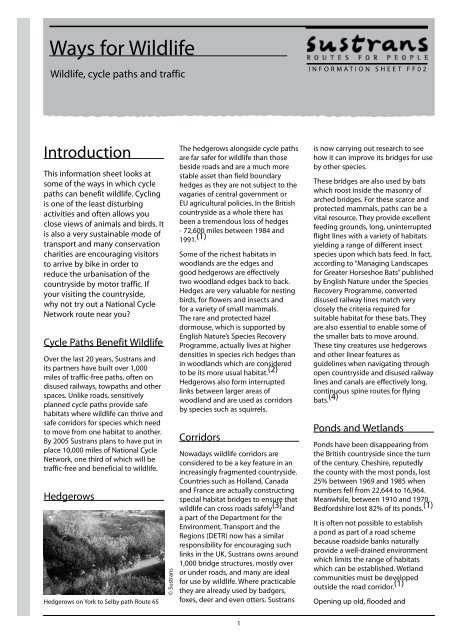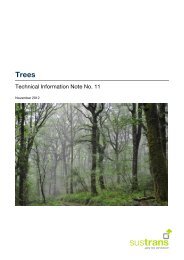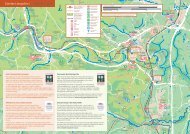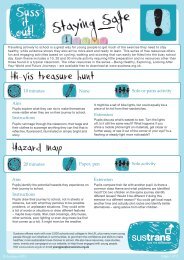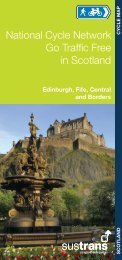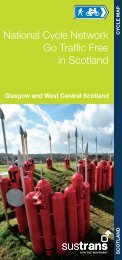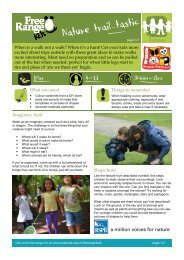Biodiversity Action Plan for the National Cycle Network ... - Sustrans
Biodiversity Action Plan for the National Cycle Network ... - Sustrans
Biodiversity Action Plan for the National Cycle Network ... - Sustrans
You also want an ePaper? Increase the reach of your titles
YUMPU automatically turns print PDFs into web optimized ePapers that Google loves.
Ways <strong>for</strong> Wildlife<br />
Wildlife, cycle paths and traffic<br />
INFORMATION<br />
SHEET FF02<br />
Introduction<br />
This in<strong>for</strong>mation sheet looks at<br />
some of <strong>the</strong> ways in which cycle<br />
paths can benefit wildlife. Cycling<br />
is one of <strong>the</strong> least disturbing<br />
activities and often allows you<br />
close views of animals and birds. It<br />
is also a very sustainable mode of<br />
transport and many conservation<br />
charities are encouraging visitors<br />
to arrive by bike in order to<br />
reduce <strong>the</strong> urbanisation of <strong>the</strong><br />
countryside by motor traffic. If<br />
your visiting <strong>the</strong> countryside,<br />
why not try out a <strong>National</strong> <strong>Cycle</strong><br />
<strong>Network</strong> route near you?<br />
<strong>Cycle</strong> Paths Benefit Wildlife<br />
Over <strong>the</strong> last 20 years, <strong>Sustrans</strong> and<br />
its partners have built over 1,000<br />
miles of traffic-free paths, often on<br />
disused railways, towpaths and o<strong>the</strong>r<br />
spaces. Unlike roads, sensitively<br />
planned cycle paths provide safe<br />
habitats where wildlife can thrive and<br />
safe corridors <strong>for</strong> species which need<br />
to move from one habitat to ano<strong>the</strong>r.<br />
By 2005 <strong>Sustrans</strong> plans to have put in<br />
place 10,000 miles of <strong>National</strong> <strong>Cycle</strong><br />
<strong>Network</strong>, one third of which will be<br />
traffic-free and beneficial to wildlife.<br />
Hedgerows<br />
Hedgerows on York to Selby path Route 65<br />
© <strong>Sustrans</strong><br />
The hedgerows alongside cycle paths<br />
are far safer <strong>for</strong> wildlife than those<br />
beside roads and are a much more<br />
stable asset than field boundary<br />
hedges as <strong>the</strong>y are not subject to <strong>the</strong><br />
vagaries of central government or<br />
EU agricultural policies. In <strong>the</strong> British<br />
countryside as a whole <strong>the</strong>re has<br />
been a tremendous loss of hedges<br />
- 72,600 miles between 1984 and<br />
1991. (1)<br />
Some of <strong>the</strong> richest habitats in<br />
woodlands are <strong>the</strong> edges and<br />
good hedgerows are effectively<br />
two woodland edges back to back.<br />
Hedges are very valuable <strong>for</strong> nesting<br />
birds, <strong>for</strong> flowers and insects and<br />
<strong>for</strong> a variety of small mammals.<br />
The rare and protected hazel<br />
dormouse, which is supported by<br />
English Nature’s Species Recovery<br />
Programme, actually lives at higher<br />
densities in species rich hedges than<br />
in woodlands which are considered<br />
to be its more usual habitat. (2)<br />
Hedgerows also <strong>for</strong>m interrupted<br />
links between larger areas of<br />
woodland and are used as corridors<br />
by species such as squirrels.<br />
Corridors<br />
Nowadays wildlife corridors are<br />
considered to be a key feature in an<br />
increasingly fragmented countryside.<br />
Countries such as Holland, Canada<br />
and France are actually constructing<br />
special habitat bridges to ensure that<br />
wildlife can cross roads safely (3) and<br />
a part of <strong>the</strong> Department <strong>for</strong> <strong>the</strong><br />
Environment, Transport and <strong>the</strong><br />
Regions (DETR) now has a similar<br />
responsibility <strong>for</strong> encouraging such<br />
links in <strong>the</strong> UK. <strong>Sustrans</strong> owns around<br />
1,000 bridge structures, mostly over<br />
or under roads, and many are ideal<br />
<strong>for</strong> use by wildlife. Where practicable<br />
<strong>the</strong>y are already used by badgers,<br />
foxes, deer and even otters. <strong>Sustrans</strong><br />
is now carrying out research to see<br />
how it can improve its bridges <strong>for</strong> use<br />
by o<strong>the</strong>r species.<br />
These bridges are also used by bats<br />
which roost inside <strong>the</strong> masonry of<br />
arched bridges. For <strong>the</strong>se scarce and<br />
protected mammals, paths can be a<br />
vital resource. They provide excellent<br />
feeding grounds, long, uninterrupted<br />
flight lines with a variety of habitats<br />
yielding a range of different insect<br />
species upon which bats feed. In fact,<br />
according to “Managing Landscapes<br />
<strong>for</strong> Greater Horseshoe Bats” published<br />
by English Nature under <strong>the</strong> Species<br />
Recovery Programme, converted<br />
disused railway lines match very<br />
closely <strong>the</strong> criteria required <strong>for</strong><br />
suitable habitat <strong>for</strong> <strong>the</strong>se bats. They<br />
are also essential to enable some of<br />
<strong>the</strong> smaller bats to move around.<br />
These tiny creatures use hedgerows<br />
and o<strong>the</strong>r linear features as<br />
guidelines when navigating through<br />
open countryside and disused railway<br />
lines and canals are effectively long,<br />
continuous spine routes <strong>for</strong> flying<br />
bats. (4)<br />
Ponds and Wetlands<br />
Ponds have been disappearing from<br />
<strong>the</strong> British countryside since <strong>the</strong> turn<br />
of <strong>the</strong> century. Cheshire, reputedly<br />
<strong>the</strong> county with <strong>the</strong> most ponds, lost<br />
25% between 1969 and 1985 when<br />
numbers fell from 22,644 to 16,964.<br />
Meanwhile, between 1910 and 1970,<br />
Bed<strong>for</strong>dshire lost 82% of its ponds. (1)<br />
It is often not possible to establish<br />
a pond as part of a road scheme<br />
because roadside banks naturally<br />
provide a well-drained environment<br />
which limits <strong>the</strong> range of habitats<br />
which can be established. Wetland<br />
communities must be developed<br />
outside <strong>the</strong> road corridor. (1)<br />
Opening up old, flooded and<br />
1


